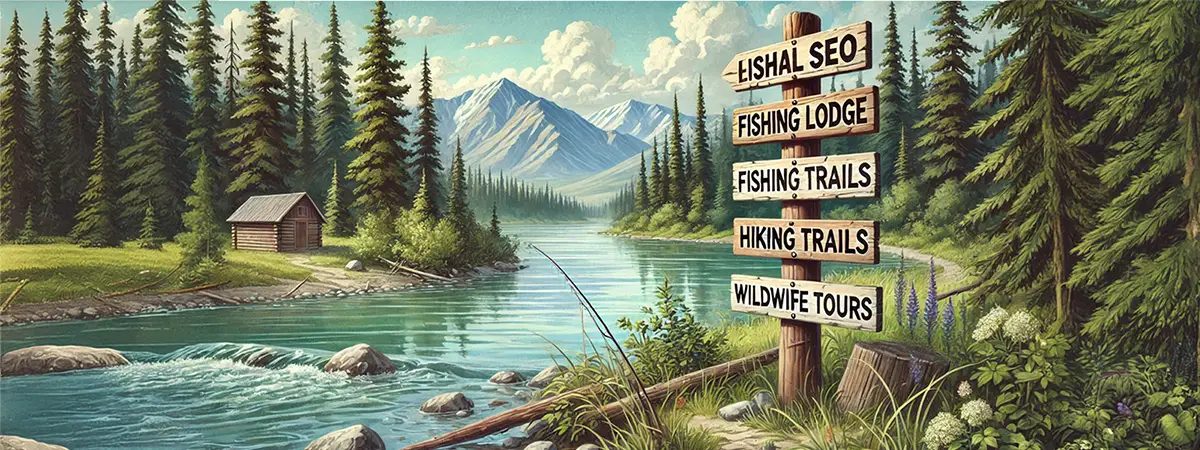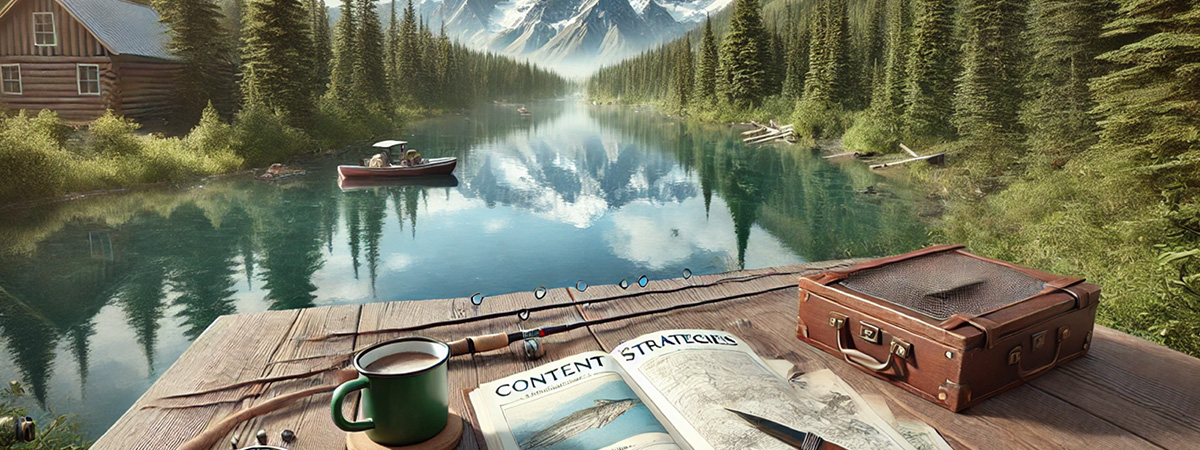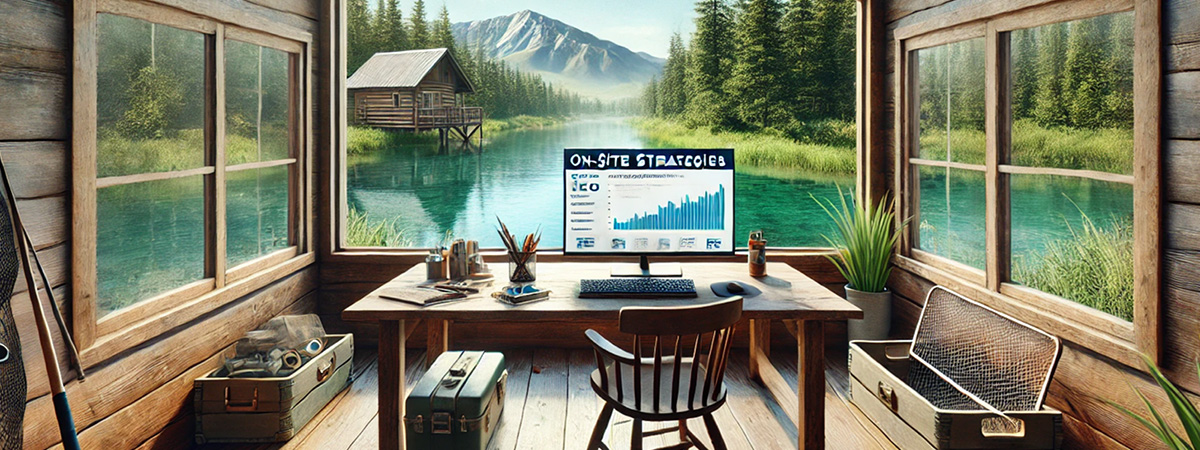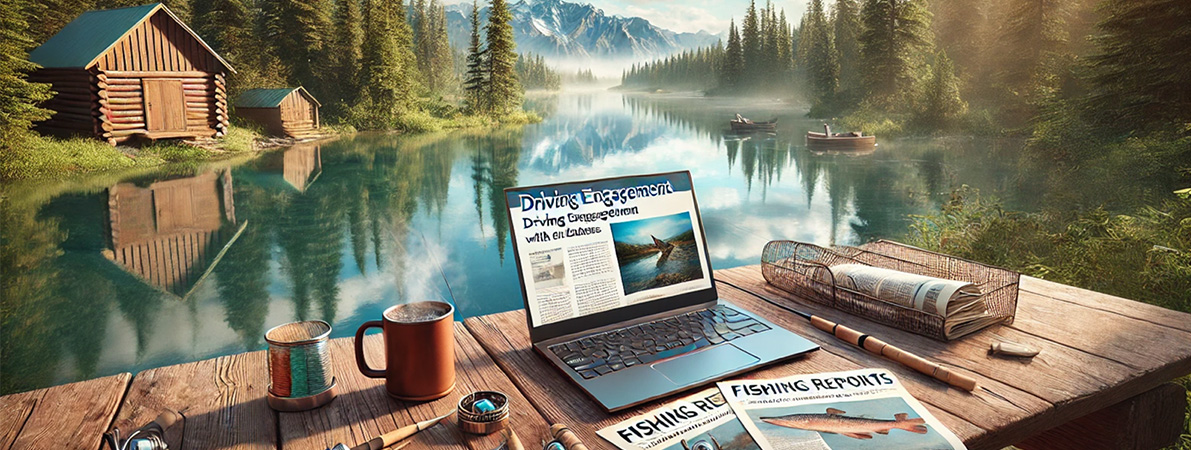In today’s competitive travel and outdoor markets, fishing lodges face a unique challenge—attracting anglers who already know where they want to go but haven’t yet decided which lodge to book. When someone searches “best salmon fishing lodges in Alaska” or “fly fishing lodges in Montana,” you want your lodge to be the one they find first. That’s where strategic, localized SEO comes in.
For fishing lodges, it’s not about reaching everyone—it’s about reaching the right people. Most guests already have a destination or a specific species in mind. Your goal? Show up in search results exactly when they’re narrowing down their options. Whether it’s a remote fly fishing retreat or a family-friendly lakeside lodge, optimizing your website for local search terms is key to turning interest into bookings.
But search engine optimization (SEO) isn’t just about keywords—it’s about visibility, trust, and user experience. From claiming your Google Business Profile to publishing species-specific content and leveraging guest reviews, there are countless ways to boost your lodge’s online presence and attract more bookings.
In this guide, we’ll break down proven SEO strategies tailored specifically for fishing lodges—helping you climb search rankings, stand out in crowded markets, and ultimately, book more trips.
Local SEO: Hook Guests Searching Nearby

When anglers search for a fishing lodge, they often start with a specific destination or species in mind—“salmon fishing lodges in Alaska” or “fly fishing retreats in Montana.” If your lodge isn’t showing up for these hyper-localized searches, you’re missing out on valuable bookings. Local SEO is about ensuring your lodge appears right when potential guests are making decisions, guiding them directly to your website.
Here’s how to strengthen your local SEO and put your fishing lodge on the map:
1. Optimize Your Google Business Profile (GBP)
Your Google Business Profile is often the first thing a potential guest will see when they search for lodges in your area. It plays a critical role in local SEO, especially for location-based searches.
Steps to optimize your GBP:
- Claim and verify your listing if you haven’t already.
- Use your official lodge name, address, phone number (NAP), and website link—ensure this info is consistent across all online platforms.
- Choose accurate categories (e.g., “Fishing Lodge”, “Outdoor Recreation”).
- Upload high-quality photos of the lodge, fishing spots, amenities, and guest experiences.
- Regularly post updates, such as seasonal specials or fishing reports.
- Encourage guests to leave reviews—and respond to them. Positive reviews help your listing stand out and signal trust to both Google and future guests.
Pro Tip: Add species-specific phrases into your GBP description, like “Premier Alaska salmon fishing lodge” or “Montana fly fishing retreat.”
2. Target Location-Based and Species-Specific Keywords
Most guests search by location or target species. Optimizing your website for these terms will help you rank higher in the search results that matter.
Focus on keywords like:
- “Alaska salmon fishing lodge”
- “Montana fly fishing retreat”
- “Luxury fishing lodges in Colorado”
- “Family-friendly bass fishing lodges in Florida”
How to implement them:
- Naturally incorporate keywords into your homepage, About page, trip details, and booking pages.
- Create species-specific pages—for example, “Steelhead Fishing in British Columbia”—that highlight targeted fishing experiences.
- Use location-based keywords in meta titles, descriptions, and H1 tags.
3. Get Listed on Relevant Directories and Booking Platforms
Boost your online presence by being listed on fishing-focused directories and tourism platforms. These sites help build credibility and drive traffic to your website.
Top directories for fishing lodges:
- TripAdvisor (for traveler reviews and booking options)
- Orvis-Endorsed Lodges (for fly fishing lodges, if applicable)
- Regional tourism websites
- Fishing-specific booking platforms (if they align with your business model)
Pro Tip: Make sure your NAP (name, address & phone) details are consistent across all platforms. Inconsistent information can hurt your local SEO rankings.
4. Leverage Guest Reviews to Build Trust and Boost Rankings
Reviews are a critical factor in both user trust and local SEO. Google favors businesses with frequent, positive reviews, and potential guests often make decisions based on them.
How to encourage more reviews:
- Send follow-up emails after guest stays, kindly requesting a review.
- Include links directly to your Google, TripAdvisor, or Yelp profiles.
- Incentivize reviews subtly—like offering a future booking discount for those who leave feedback (if the platform allows).
- Don’t ignore negative reviews—respond professionally and show potential guests that you value customer satisfaction.
5. Build Localized Content Around Your Region and Fishing Opportunities
Content is still king, especially when it’s location-specific. By regularly updating your website with local content, you’ll rank higher for searches targeting your area and appeal directly to anglers.
Content ideas for fishing lodges:
- Seasonal fishing guides: “Best Times for King Salmon Fishing in Alaska”
- Local attraction spotlights: “Top Things to Do Near Our Montana Fishing Lodge”
- Species profiles and tactics: “Fly Fishing for Trout in British Columbia’s Rivers”
- Guest stories and trip recaps: Showcase memorable catches and customer experiences.
SEO Bonus: Include keywords naturally within these posts and link them to your core pages (like your booking page), which strengthens your internal SEO.
The Local SEO Advantage for Fishing Lodges
By focusing on localized SEO strategies, you position your lodge to appear when it matters most—when anglers are searching for a place to stay and fish. Whether it’s a fly fisherman planning a trip months in advance or a family looking for a last-minute weekend getaway, showing up in those search results means more bookings and a stronger online presence.
Content Strategies for Fishing Lodges: Attract More Guests with the Right Stories

A strong content strategy isn’t just about stuffing your site with keywords—it’s about telling the stories anglers want to hear. For fishing lodges, that means showcasing the fishing experience, the species guests can target, and the adventure that awaits them. But it also means strategically organizing content to rank well in search engines and guide potential guests toward booking.
Just as importantly, most fishing lodges offer much more than fishing. From wildlife photo excursions to kayaking, hiking, or bear viewing, these additional activities attract families, mixed-interest groups, and even non-anglers who want to immerse themselves in nature. Highlighting these experiences not only broadens your lodge’s appeal but also helps fill more rooms—especially for families or groups where not everyone is focused solely on fishing.
Here’s how to create content that both search engines and fishing enthusiasts will love:
1. Build Species-Specific Pages to Target Angler Interests
One of the first things anglers search for is the type of fish they can target. By creating dedicated pages for each species, you’ll not only appeal directly to what guests want but also optimize your site for specific search queries.
Tips for species pages:
- Create individual pages for each popular species in your area (e.g., “Salmon Fishing at Our Alaska Lodge” or “Fly Fishing for Rainbow Trout in Montana”).
- Include information like peak seasons, recommended techniques, and guest success stories.
- Add high-quality photos of catches, scenic shots, and guests in action.
- Include a call-to-action (CTA) on each page, such as “Book Your Guided Salmon Fishing Trip”.
SEO Bonus: Use long-tail keywords like “best steelhead fishing lodge in British Columbia” or “guided tarpon fishing trips in Florida.”
2. Highlight Non-Fishing Activities to Attract a Broader Audience
Not every guest comes solely for the fishing. Many lodges attract mixed groups—some guests fish, others prefer wildlife tours, kayaking, or just soaking in the scenery. Showcasing these non-fishing activities can help fill more rooms and appeal to a wider range of travelers.
How to promote additional experiences:
- Create dedicated pages for popular activities like bear viewing, wildlife photography excursions, kayaking, hiking, or diving.
- Include blog posts that highlight these experiences, such as:
- “Top 5 Wildlife Tours Near Our Lodge”
- “Family-Friendly Activities at [Lodge Name]”
- “The Ultimate Alaska Adventure: Fishing, Bear Viewing, and More”
- Use guest stories and testimonials from non-anglers who enjoyed the lodge.
- Include these activities in booking pages, offering package deals that combine fishing and non-fishing excursions.
Pro Tip: Families often choose lodges based on the variety of activities offered—highlighting options beyond fishing can make your lodge more appealing to larger groups.
3. Create Seasonal Content to Capture Year-Round Traffic
Fishing seasons vary, and so do search habits. Publishing seasonal content helps your lodge stay visible year-round, even during off-peak times.
Ideas for seasonal blog posts and pages:
- “Spring Fly Fishing Tips for Montana Rivers”
- “Fall Steelhead Runs: When to Book Your Trip”
- “Winter Lodge Activities Beyond Fishing” (to attract guests during slower months)
- “Top 5 Summer Fishing Tactics for Big Bass”
- “Best Wildlife Viewing Spots Near Our Lodge”
Why it works: Search engines love fresh, timely content. Plus, guests planning trips around peak seasons—whether for fishing or other outdoor activities—will find exactly what they’re looking for.
4. Share Guest Stories and Trip Reports to Build Trust
Fishing is about more than the catch—it’s about the experience. Sharing guest stories and trip recaps not only adds fresh content but also builds trust with potential guests.
How to make the most of guest stories:
- Post regular trip reports detailing recent fishing adventures, including species caught, weather conditions, and notable moments.
- Highlight non-fishing experiences too—like wildlife sightings, family excursions, and unique moments at the lodge.
- Include guest testimonials and feature quotes about their stay, focusing on both fishing and other activities.
- Encourage guests to share photos and stories post-trip—then feature them on your site.
Pro Tip: End every trip report with a CTA like “Ready to plan your fishing adventure? Book your stay today!”
5. Optimize Content for Long-Tail Keywords and Voice Search
Most anglers aren’t just searching for “fishing lodge”—they’re using detailed phrases like “best salmon fishing lodge in Alaska” or asking questions like “When is the best time to fish for tarpon in Florida?” Optimizing for these long-tail keywords can help you rank for highly specific searches.
How to optimize for long-tail and voice search:
- Answer common angler and traveler questions in blog posts and FAQs.
- Use natural, conversational language in content (helpful for voice search queries).
- Incorporate phrases like “where to fish for king salmon in Alaska” or “family-friendly fishing lodges in Montana.”
- Structure content using H2 and H3 headings that match common search queries.
6. Incorporate Rich Media for Engagement (and SEO)
Fishing lodges are visually appealing, and your content should reflect that. Rich media like photos, videos, and interactive maps not only engage visitors but also improve SEO.
Best practices for media-rich content:
- Include optimized images with descriptive file names (e.g., “alaska-salmon-fishing-lodge.jpg”).
- Use alt text with relevant keywords for each image.
- Share short videos showcasing the lodge, fishing action, wildlife tours, or guest testimonials.
- Embed interactive maps showing your lodge’s location, nearby fishing spots, and wildlife viewing areas.
SEO Tip: Compress images to reduce load time—slow pages can negatively impact rankings.
Content That Converts Guests into Bookings
Content isn’t just about climbing Google rankings—it’s about showing guests why your lodge is the perfect choice for their next adventure. By creating species-focused pages, highlighting non-fishing activities, and sharing guest stories, you’ll attract a wider audience and ultimately boost bookings.
Mobile Optimization & Performance: Don’t Let Guests Bounce

When potential guests land on your fishing lodge’s website, you have just seconds to capture their attention. If your site is slow, difficult to navigate, or not mobile-friendly, many users will leave before they even see your booking options. In fact, studies show that more than half of website traffic comes from mobile devices—and that number only increases when it comes to travelers planning trips on the go.
Mobile optimization and website performance aren’t just about user experience—they’re key factors in SEO. Google prioritizes fast, mobile-friendly websites in search rankings. A slow, clunky site won’t just frustrate potential guests—it’ll push you further down the search results, making it harder for travelers to find your lodge in the first place.
Here’s how to make sure your fishing lodge website runs smoothly, ranks well, and keeps users engaged:
1. Make Your Website Fully Mobile-Responsive
A mobile-responsive website automatically adjusts its layout and content based on the device being used. Whether someone’s viewing your site on a smartphone, tablet, or desktop, they should have a seamless browsing experience.
Mobile optimization essentials:
- Use a responsive design that adapts to all screen sizes.
- Ensure navigation menus are easy to tap and interact with on mobile devices.
- Keep call-to-action (CTA) buttons large and easy to click—especially “Book Now” or “Contact” buttons.
- Avoid cluttered layouts. Stick with clean designs that highlight your key selling points.
- Test your website on multiple devices to ensure everything functions as intended.
Pro Tip: Google’s Mobile-Friendly Test tool lets you see how your site performs on mobile devices and highlights issues that need fixing.
2. Speed Up Load Times to Reduce Bounce Rates
Slow websites don’t just frustrate users—they directly impact your SEO. Google includes page speed as a ranking factor, and research shows that even a one-second delay in load time can lead to a 7% reduction in conversions.
Ways to improve site speed:
- Compress images without sacrificing quality. Fishing lodges often feature high-resolution photos, but large files can slow down your site. Use tools like TinyPNG or ImageOptim to reduce file sizes.
- Implement lazy loading for images and videos so they load only when users scroll to them.
- Minimize the use of heavy scripts and unnecessary plugins.
- Enable browser caching and content delivery networks (CDNs) to reduce server load and speed up content delivery.
- Regularly test page speed using tools like Google PageSpeed Insights or GTmetrix.
3. Optimize for Core Web Vitals
In 2021, Google introduced Core Web Vitals as part of its ranking algorithm. These vitals focus on user experience metrics, such as load times, interactivity, and visual stability.
Core Web Vitals include:
- Largest Contentful Paint (LCP): Measures how quickly the largest visible content loads (aim for under 2.5 seconds).
- First Input Delay (FID): Tracks how quickly your website responds when a user interacts with it (target under 100 milliseconds).
- Cumulative Layout Shift (CLS): Ensures that elements on the page don’t shift unexpectedly as it loads (keep this below 0.1).
Tips for improving Core Web Vitals:
- Use optimized images and minimize large file sizes.
- Implement efficient caching and fast hosting solutions.
- Minimize layout shifts by setting fixed dimensions for images, videos, and embedded elements.
4. Prioritize Simple, Intuitive Navigation
When users land on your site—especially on mobile—they should be able to find what they need quickly. Complicated menus and hidden pages increase bounce rates.
Navigation best practices:
- Use a simple top navigation bar with essential links like Trips & Rates, Lodge Information, Activities, and Booking.
- Include a sticky header (on mobile) with your primary CTA—like “Book Now” or your phone number.
- Use clear labels for all menu items. Don’t get creative with terms that users may not recognize.
- Ensure your most important pages are no more than two clicks from the homepage.
Pro Tip: For mobile users, a hamburger menu (☰) is familiar and effective—but ensure it’s easy to open and navigate.
5. Streamline the Booking Process for Mobile Users
Many potential guests will book directly from their phones. If your booking process is complicated or hard to use on mobile, you risk losing them.
How to simplify bookings:
- Make sure your booking form is mobile-optimized and easy to fill out.
- Use large buttons and dropdowns where possible, reducing the need for typing.
- Include a clear confirmation message after booking and follow up with a confirmation email.
- Allow for simple contact options—like click-to-call or direct messaging—especially for guests who may want to ask questions before booking.
Why Mobile Optimization Matters for Fishing Lodges
Potential guests are often researching trips while on the go—whether planning months in advance or looking for a last-minute weekend getaway. A slow, clunky, or hard-to-navigate website could mean the difference between a fully booked season and missed opportunities.
Optimizing your fishing lodge’s website for speed, mobile usability, and user experience doesn’t just help with search rankings—it directly leads to more bookings. By giving guests the information they need, when and how they want it, you’ll convert more visitors into paying customers.
On-Site SEO Strategies: Building a Site That Search Engines (and Guests) Love

While off-site factors like backlinks and online reviews play a role in SEO, a well-optimized website is still the foundation of any successful search strategy. For fishing lodges, effective on-site SEO ensures that search engines can easily crawl, index, and rank your pages—while also providing guests with a seamless browsing experience that encourages bookings.
Here’s how to structure your website and fine-tune its content to rank higher and convert more visitors:
1. Optimize Core Website Pages with Strategic Keywords
Your website’s core pages—like your homepage, trip descriptions, species pages, and booking information—should be optimized for the search terms your ideal guests are using.
Where to use strategic keywords:
- Homepage: Include location-based terms like “Alaska fishing lodge” or “fly fishing lodge in Montana.”
- Species Pages: Optimize for specific searches like “best steelhead fishing lodge” or “rainbow trout fly fishing trips.”
- Activity Pages: If you offer additional activities (e.g., bear viewing or kayaking), create dedicated pages optimized for those experiences.
- Booking Pages: Optimize for intent-based searches like “book all-inclusive fishing lodge” or “guided salmon fishing trips.”
Best practices for keyword placement:
- Use your primary keyword in the H1 tag, meta title, and meta description.
- Naturally include keywords within the first 100 words of each page.
- Avoid “keyword stuffing”—focus on readability and user experience.
2. Use Internal Linking to Boost SEO and Improve Navigation
Internal links help both users and search engines navigate your site. They guide visitors to related content, encourage them to explore more pages, and help search engines understand the structure of your website.
How to use internal links effectively:
- Link blog posts and trip reports to relevant species pages or booking information.
- From your homepage, link directly to key landing pages like “Guided Fishing Trips” or “Lodge Amenities.”
- On species pages, include links to trip rates and availability calendars.
- Use descriptive anchor text (e.g., “Learn more about our rainbow trout fishing trips” rather than “Click here”).
SEO Tip: The more internal links a page has pointing to it, the more important it appears to search engines—so link generously to your booking page!
3. Optimize Meta Titles, Descriptions, and Header Tags
Meta titles and descriptions are the first things potential guests see when your website appears in search results. Optimizing them not only improves your click-through rates but also helps boost your rankings.
Tips for optimizing metadata:
- Keep meta titles under 60 characters and include the primary keyword (e.g., “Alaska Salmon Fishing Lodge | [Lodge Name]”).
- Write compelling meta descriptions (150-160 characters) that encourage users to click (e.g., “Experience world-class salmon fishing, luxury lodging, and wildlife tours at our premier Alaska fishing lodge.”).
- Use H1 tags for page titles and H2/H3 tags for subheadings to improve readability and SEO.
- Make sure every page has a unique title and description—avoid duplicates.
4. Leverage Structured Data (Schema Markup) for Rich Results
Structured data, also known as schema markup, is code added to your website that helps search engines understand your content more clearly. It can enhance your search results by displaying rich snippets—like star ratings, event dates, and FAQs—making your listing more eye-catching in search results.
Key schema types for fishing lodges:
- Lodging Business: Highlight amenities, location, pricing, and contact information.
- Event Schema: If you host seasonal fishing tournaments or special events, mark them up for better visibility.
- Review Schema: Showcase guest ratings and testimonials directly in search results.
- FAQ Schema: Include frequently asked questions on your site to increase the chances of your content appearing in rich results.
Pro Tip: Use Google’s Structured Data Testing Tool to verify that your schema markup is properly implemented.
5. Focus on User Experience (UX) for Higher Engagement
Search engines prioritize websites that offer great user experiences. If guests stay longer on your site, visit multiple pages, and complete bookings, search engines interpret these signals as indicators of a high-quality site.
UX improvements that boost SEO:
- Use clear calls-to-action (CTAs) on every page, guiding users toward booking.
- Break up text with bullet points, headings, and high-quality images to improve readability.
- Ensure that forms—especially your booking form—are simple and mobile-friendly.
- Include trust signals like guest reviews, safety certifications, and affiliations with fishing organizations.
6. Improve Accessibility for All Users
Accessibility is a growing focus in web design—and it can impact SEO. Making your site usable for everyone, including those with disabilities, improves engagement and can help you rank higher.
Accessibility tips:
- Add alt text to all images, describing the content for visually impaired users.
- Use descriptive link text rather than vague terms like “click here.”
- Ensure your site’s color contrast is strong enough for all users to read easily.
- Implement keyboard navigation for users who rely on non-mouse inputs.
A Strong SEO Foundation Means More Bookings
Effective on-site SEO makes it easier for search engines to rank your fishing lodge—and easier for potential guests to navigate your site and book their stay. By optimizing your core pages, leveraging internal links, and focusing on user experience, you’ll create a website that not only ranks well but also converts more visitors into bookings.
Driving Engagement with Blogs, Fishing Reports, and Seasonal Content

For fishing lodges, static web pages like “Trips & Rates” or “About the Lodge” provide essential information—but they rarely change. While these pages are vital for SEO, search engines also prioritize websites that frequently update content and demonstrate ongoing activity. That’s where blogs, fishing reports, and seasonal content come into play.
Regularly updated content not only signals to search engines that your site is active but also helps attract repeat visitors, target seasonal search trends, and engage potential guests throughout the year. Even better? It showcases your expertise and gives guests a real-time glimpse of what’s happening at your lodge.
Here’s how to use fresh, dynamic content to boost your SEO, engage visitors, and drive more bookings:
1. Post Consistent Fishing Reports and Trip Recaps
Fishing reports are a goldmine for SEO and guest engagement. They provide real-time updates on fishing conditions, showcase recent catches, and give potential guests an idea of what they can expect when they book a trip.
What to include in fishing reports:
- Dates & locations of recent trips
- Species caught and any notable successes (trophy fish, unique catches)
- Techniques used (e.g., fly fishing, spin casting)
- Weather & water conditions
- Guest stories and high-quality photos of anglers and their catches
Why fishing reports matter for SEO:
- They naturally include long-tail keywords like “spring salmon fishing in Alaska” or “fly fishing for trout in Montana rivers.”
- Frequent updates signal to search engines that your website is active.
- They attract repeat visitors who want to stay updated on local fishing conditions.
Pro Tip: Include a CTA at the end of each report, like “Want to be featured in our next trip report? Book your stay today!”
2. Create Seasonal Content That Aligns with Fishing Patterns
Fishing is highly seasonal, and anglers often plan trips around peak fishing times. Publishing seasonal blog posts and content helps your lodge stay visible in search results year-round—especially during slower booking periods.
Ideas for seasonal blog posts:
- “Best Time of Year to Fish for Steelhead in British Columbia”
- “What to Pack for a Summer Fly Fishing Trip”
- “Fall Fishing in Alaska: Targeting Coho Salmon”
- “Winter Activities at Our Lodge Beyond Fishing”
- “Top 5 Wildlife Photography Spots Near Our Lodge”
Why seasonal content works:
- It captures guests who are planning trips around specific fishing seasons.
- It gives you an opportunity to target seasonal keywords like “spring trout fishing in Montana” or “best summer fishing lodges in Alaska.”
- It helps fill off-peak times by promoting non-fishing activities (like wildlife tours or kayaking) during slower fishing seasons.
3. Target Long-Tail Keywords with Niche Blog Posts
Long-tail keywords are specific search terms that often have lower competition but higher intent. For example, instead of targeting a broad term like “fishing lodge,” aim for more detailed searches like “family-friendly fly fishing lodges in Colorado” or “where to fish for tarpon in Florida.”
How to create blog posts targeting long-tail keywords:
- Use common guest questions as blog topics (e.g., “When’s the Best Time to Fish for King Salmon?”).
- Highlight specific experiences, like “Fly Fishing for Rainbow Trout in High-Altitude Lakes” or “Top Wildlife Tours Near Our Lodge.”
- Use conversational titles that align with voice search (e.g., “What’s the Best Fly for Early-Season Trout?”).
SEO Bonus: Long-tail keywords are often used by guests who are closer to booking—so these blog posts can directly drive conversions.
4. Promote Non-Fishing Activities to Attract a Broader Audience
Many lodges attract guests who aren’t solely interested in fishing. Highlighting alternative activities—like wildlife tours, kayaking, or hiking—broadens your appeal to families, mixed-interest groups, and nature lovers.
Content ideas for non-anglers:
- “Wildlife Photography Tours: Spotting Bears, Moose, and Eagles”
- “The Best Hiking Trails Near Our Lodge”
- “Top Family-Friendly Activities for Non-Anglers”
- “Kayaking Adventures: Paddle Through Alaska’s Remote Waters”
Including non-fishing content helps attract guests who may have fishing family members but want other experiences themselves—and it’s an opportunity to rank for non-fishing-related search terms.
5. Share Content Across Social Media to Drive Traffic
Every fishing report, blog post, or seasonal guide you create can double as a social media post. Sharing content on platforms like Facebook, Instagram, and Twitter not only drives traffic to your site but also helps keep your lodge top-of-mind for past and future guests.
Tips for promoting content:
- Share snippets from blog posts with a link to read more.
- Post photos from recent fishing trips alongside links to full trip reports.
- Encourage guests to share their photos and stories, then feature them in your posts.
- Use hashtags related to fishing, travel, and your region (e.g., #AlaskaFishingLodge, #FlyFishingLife, #MontanaWildlifeTours).
Pro Tip: Tag guests (with their permission) when sharing photos—they’re more likely to share your posts with their network, increasing your reach.
Content That Keeps Guests (and Search Engines) Coming Back
Consistent, high-quality content is the secret weapon for fishing lodge SEO. Blogs, fishing reports, and seasonal guides not only keep your website fresh in search engines but also build a community of engaged past, current, and future guests. Whether you’re targeting anglers, wildlife photographers, or families planning their next outdoor adventure, dynamic content helps your lodge stay top-of-mind—and top of the search results.
Wrap-Up: Reel In More Guests with a Strong SEO Strategy

Ranking higher on Google isn’t just about using the right keywords—it’s about creating a comprehensive strategy that combines smart SEO practices, high-quality content, and a seamless user experience. For fishing lodges, this means showing up when potential guests are actively planning their next trip, whether they’re searching for “best salmon fishing lodge in Alaska” or “family-friendly fishing trips in Montana.”
By focusing on localized SEO, optimized website structure, and engaging content, you can position your lodge in front of more travelers, boost bookings, and build a loyal base of returning guests. And don’t forget: it’s not just about attracting hardcore anglers. Highlighting additional activities—like wildlife tours, kayaking, or photography excursions—helps you appeal to a broader audience, from families to nature enthusiasts.
Ready to grow your fishing lodge’s online presence and attract more guests?
Let Thrive Creative Labs help you craft an SEO strategy that drives real results. From optimized websites to content strategies tailored for fishing lodges, we’ll make sure your business gets found by the right guests—at the right time.